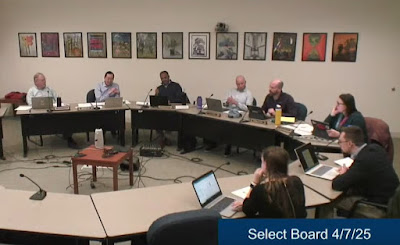This letter to the Select Board was sent by Mark Gold, a former Longmeadow Select Board member recommending a Vote NO on Article #4 at the Longmeadow Special Town Meeting on Tuesday, November 4.
_________________________________________________
M Gold <mgold129@yahoo.com> Wed, Oct 29, 2025 at 3:58 PM
To: "selectboard@longmeadowma.gov" <selectboard@longmeadowma.gov>, "jlevine@longmeadowma.gov" <jlevine@longmeadowma.gov>, "alam@longmeadowma.gov" <alam@longmeadowma.gov>, "vhemavathi@longmeadowma.gov" vhemavathi@longmeadowma.gov>
Cc: "adminassistant@longmeadowma.gov" "lsimmons@longmeadowma.gov"
To the Longmeadow Select Board:
I've stayed away from town politics for the past four months, feeling that the Select Board deserves the right to oversee the town without the peanut gallery getting involved. But my recent reading of Article 4 on the warrant for the November 4th Special Town meeting requires my comments, primarily because it has misinterpreted at best, and twisted at worst, the intent of the streetlight purchase and LED conversion.
Let there be no misunderstanding: the funds that are under discussion for being placed into a "revolving fund", both the lump sum amount and the ongoing revenue stream, are the direct result of the conversion of our streetlights to LEDs. I believe I may be one of only a handful of town residents who lived and understand this entire story. I am happy to go into greater detail at your request, but there can no disagreement that the funds under discussion resulted from the conversion of streetlights to LEDs and the SIGNIFICANT reduction in electricity use in the accounts that charge the town for powering our street lights.
The concern I have, and the reason for this letter, is that the street light purchase and LED conversion was done for one reason, and one reason only: to reduce the cost of that line item in the town budget and allow for the control, if not lowering, of the Longmeadow tax rate. The street light purchase and LED conversion was NOT done to create a "DPW Electricity and Energy Improvement Revolving fund". The diversion of funds from lowering taxes to providing a special fund is a significant deviation from the intent of the LED conversion program. No one, particularly me who individually worked extensively on this program, went through the effort of converting our streetlights so we could create a (pardon the expression, but it seems to apply here) slush fund for the DPW to use to address issues as they see fit.
The purchase of the streetlights has indeed reduced the street light line item cost by eliminating light and pole rental charges. This purchase was accompanied by the conversion of our streetlights to LEDs, and that conversion was not done only to be more "green" and reduce our energy consumption, it was specifically directed at reducing our energy (and overall budget) costs. To divert those saved funds from a reduction in the budget (and effectively a reduction in the taxes that need to be raised) to a revolving fund is a disregard for the intent of town residents and the vote of the town meeting at which funds were appropriated for LED conversion.
In summary, I believe the Select Board and town administration is wrong in submitting this proposal to Town Meeting. The intent of the street light conversion to LEDs cannot be misinterpreted, and as the person who identified this cost savings opportunity and who, along with our Town Manager, worked harder than anyone in town to make this happen, I can state unequivocally that Warrant Article #4 gets it wrong on every account. We should be using the revenue (and accumulated lump sum) into reducing our energy costs and our taxes.
Therefore, I intend to vote against this warrant article, and urge all town residents to also vote against Warrant article #4 at the November 4th Special Town meeting. Funds returned to the town as energy credits should be used to pay other energy costs in town (ideally electricity) and reduce the overall budget of the town.
Regards,
Mark Gold
P.S. This letter should appear as "correspondence" in the November 3rd Select Board distribution packet as it is directed to a majority of the Select Board members. To delay it's distribution until after the Special Town Meeting is to further disregard the intent of the voters.







